A feast of form in my twitter-stream today
[ by Charles Cameron — forms & patterns, pattern recognition & creative leaps, creative leaps & connecting dots, connecting dots & node-and-edge mapping — node-and-edge mapping, link charts and Sembl-HipBone games ]
.
.
There’s no “actionable intelligence” in that tweet, but it recognizes a pattern, it makes a fine creative leap. And given the chance, that’s something bright minds do naturally, and enjoy doing, and is away more important than we think.
Yestedrday I was watching Manhunt pretty closely for an upcoming Zenpundit review, and noticed that some of the most significant quotes in the film were absent from CNN’s transcript. One gap I noticed had to do with the descriptions of the analytic process, and in particular some of the things Cindy Storer said. I’ll quote this one, which goes to the heart of the matter, but there’s plenty more left for me to chew over with you later. Here she goes:
Even in the analytical community there’s a relatively smaller percentage of people who are really good at making sense of information that doesn’t appear to be connected. So that’s what we call pattern analysis, trying to figure out what things look like. And those people, you really need those people to work on an issue like terrorism, counternarcotic, international arms trafficking, because you’ve got bits and pieces of scattered information from all over the place, and you have to try to make some sense of it. … That takes this talent, which is also a skill, and people would refer to it as magic — not the analysts doing it, but other people who didn’t have that talent referred to it as magic.
That’s a pretty exact description of what the Sembl game will eventually teach people, once it comes out of the museum prototype and onto the web — but let’s back it up with a quick quote from Wittgenstein:
A surveyable representation produces precisely that kind of understanding which consists in ‘seeing connections’ [Zusammenhänge sehen]. Hence the importance of finding and inventing connecting links. Hence the importance of finding and inventing intermediate links.
That’s from Philosophical Investigations, 122, and it’s a higher altitude / more abstract view — but it’s also the very heart of network thinking, seeing processes not just in terms of isolated nodes but of the connections between them.
**
Seeing connections — connecting the dots — happens in lines and leaps. That is to say, it can happen according to the usual linear way of thinking, the dogged 99% of perspiration that people talk about — or according to the far less common lateral move or creative leap, which moves by analogy, which is to say by pattern recognition, by the perception of similarities of form.
That’s the 1% we call inspiration. That’s the magic.
**
So a whole lot of patterning was going on in my twitter-stream today, and I thought I’d show you.
First, there was the parallel between the names Mokhtar Belmokhtar and Jean Valjean (above). If you’re hunting either fellow, the parallelism isn’t going to yield a useful clue — but the mode of recognition is what matters, and the reason its such a rare mode is precisely because it’s playful. It plays with forms — in this case, the forms of the two names — without regard for practicality.
And yet this playful spirit is what brought us Weil‘s conjecture and Pierre Deligne‘s Abel Prize, and the Taniyama-Shimura conjecture and Wiles‘ proof of Fermat’s Last Theorem.
Serious playfulness is key… to serious, magical breakthroughs. In any and all domains.
*
With that in mind, here are the rest of the patterns I recognized in todays feed.
Let’s start with self-reference, which can hardly get more succinct than the hackers hacked:
There’s also a self-referential paradox at work in the question of a defendant appearing in his own defense — something that gives judges pause, because they see how tightly the serpent is chasing its own tail. Defendant defends self, From Raff Pantucci:
The saddest self-reference of the morning’s tweets was this one, which could be encapsulated as storm-chaser chased by storm:
Even tragedy can take self-referential form.
**
But lets move on to Turkey, which provided a rich dividend:
There was this problem:
Turkish I couldn’t read, Dutch I can more or less make out — but for an English tweet making the same point let’s go to Zeynep Tufekci, who has expertise in both matters Turkish and matters Internet, and tweets about Erdogan disapproving of tweeting:
Tufekci again, this time catching an even neater self-reference which doesn’t quite pan out — because, as she says, PM Erdogan is not the same as @RT_Erdogan:
**
While we’re on Turkey, this tweet about Tienanmen, Tahrir and Taksim Squares gave us another example of a bright mind catching a hint of pattern…
And what a neat rejoinder!
All of the above is quite useless, entirely playful — and of deep interest if creativity and insight matter…
**
Finally, I’d like to go someplace quiet and bathe in peace. This tweet, featuring a poem by a Korean zen master, does the trick nicely:
AN appreciative bow to Gwarlingo for that one…


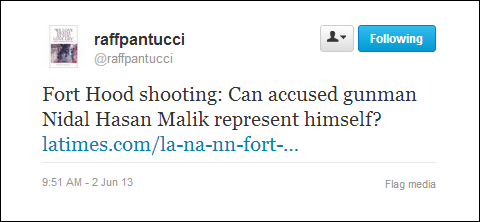
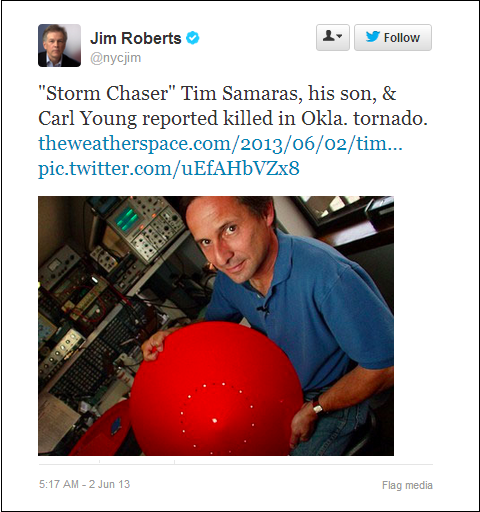
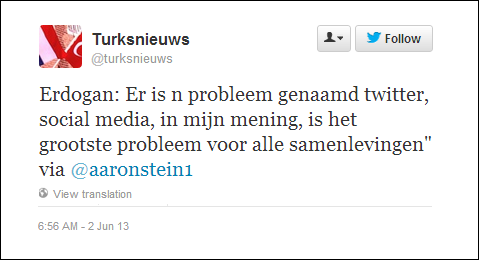


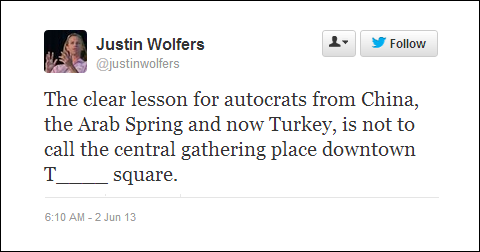
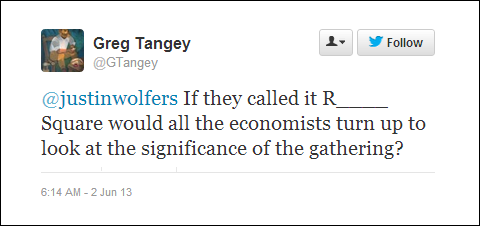
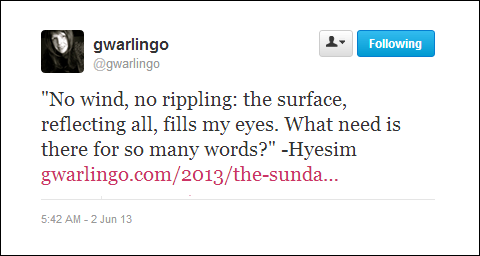



June 3rd, 2013 at 7:29 pm
And today:
June 8th, 2013 at 1:48 am
Here’s a tasty self-reference with a Moebius twist:
.
June 8th, 2013 at 4:46 am
And a great one here, from evolutionary biologist Bret Weinstein:
.
June 9th, 2013 at 7:00 pm
Two from today:
to which Khanserai wittily responded:
and another fine one from Allan Stairs:
June 14th, 2013 at 10:59 pm
June 14th, 2013 at 11:22 pm
June 22nd, 2013 at 10:27 pm
Another goodie:
The mind boggles, boggles.
June 23rd, 2013 at 8:45 pm
This one, again from Allan Stairs, is simply terrific: it manages to hit my marks for apocalyptic, geopolitical and MoebiusTweet recursiveness in four short words:
June 24th, 2013 at 3:03 pm
Oficialdom being transparent about official secrets…
.
June 27th, 2013 at 11:56 pm
I’m pretty sure these two belong here, but it would be a complex matter for me to explain exactly why!
.
.
June 29th, 2013 at 6:47 pm
And in all fairness, is those two count, this one should too:
June 29th, 2013 at 7:39 pm
I’m using this post as a continuing stash of these things, obviously, and some of my examples have no practical relevance beyond pointing out that the form — reflexivity, self-reference, whatever you want to call it — is both easily recognized, and something that at least some tweeps find interesting enough to comment on. I don’t suppose, for instance, that the sermon Joel Rosenbers heard on the Sea of Galilee was the only sermon preached on his tour, but preaching about Jesus walking on water when you yourself are on the very same “Sea of Galilee” where the gospels describe Jesus as doing this is clearly self-referential, and that’s why this one gets singled out for mention — and the same goes for Rosenberg’s tweets about being at Megiddo / Armageddon, ground zero for the apocalypse.
.
This next one shows, I think, how self-reference — in this case, suicide — can have powerful implications:
Self-reference is like a “knot” in wood — only it’s a “know” in meaning.
June 30th, 2013 at 4:16 pm
Today’s example comes from Pundita’s blogpost Snowden reveals NSA spied on E.U. officials:
The thing that makes this the “best comment”, IMO, is that it uses recursive form to deliver its insight. Elegant.
.
Which reminds me that Quis custodiet ipsos custodes? is itself one of the key instances of reflexivity…
June 30th, 2013 at 11:37 pm
As as if to emphasize the Quis custodiet? theme by illustration:
July 1st, 2013 at 6:17 pm
And here I am, doing it myself:
July 3rd, 2013 at 5:31 pm
Three strikes, you’re out?
July 3rd, 2013 at 10:14 pm
Shloky on form:
July 5th, 2013 at 11:58 pm
Two for today:
and:
July 6th, 2013 at 10:39 pm
And gosh, from our own J Scott, I believe this belong here:
.
July 9th, 2013 at 4:54 am
This one’s brilliant!
.
.
Too bad the paper it’s about is behind a $40 paywall.
July 10th, 2013 at 2:00 am
Deeply sad:
.
July 10th, 2013 at 8:51 pm
I think this one qualifies:
.
.
More pointedly ouroboric, though, was the death of John Patrick O’Neill:
.
I think it’s pretty clear to the pattern-seeking human mind that leaving the FBI where you’ve been working counter-AQ to become security chief at WTC and die in the 9/11 attacks is recursive — someone from the AQ side might term it “poetic justice” — but while the mind can easily grasp the circularity, I don’t think expressing that insight in definitional language so that the circularity was unambiguous would be an easy task. In a visual graphic, yes, perhaps. In an intuitive leap, certainly. But the distance between intuition and verbalized logic here is fascinating, calls for further comment.
July 11th, 2013 at 6:31 pm
One thing that’s becoming clear here is that my philosopher friend Allen Stairs has a real flair for the recursive…
July 17th, 2013 at 12:11 am
And how’s this for a hilariously twisted geeky self-referential spoof?
.
July 20th, 2013 at 7:52 pm
From Gregory Johnsen again:
.
July 20th, 2013 at 8:40 pm
And another from Shari VanderWerf:
.
.
Hilarious. Clearly, some people just have a knack for this…
July 20th, 2013 at 9:44 pm
30 days has september, so at least the days in September Shari VanderWerf is going to get back. I hope they were very good days… and this is why the NSA needs to spy on its citizens.
July 20th, 2013 at 10:18 pm
Larry, I think you’ve slipped into Lynn C Rees’s time-stream, perhaps unknowingly? ; )
July 20th, 2013 at 10:20 pm
and then there’s this:
.
.
When I look at that video, the image I see is of a boomerang, which is not something the song itself mentions, btw — the ultimate in blowback weaponry? Karma as “what goes around, comes around”? Whatever — props to the guy who chose that graphic for that song.
July 20th, 2013 at 10:49 pm
“Larry, I think you’ve slipped into Lynn C Rees’s time-stream, perhaps unknowingly? ; )”
*
Ha! Perhaps 🙂
*
But a month is a month. The question might be: is the NSA going to get any of it back?
July 22nd, 2013 at 7:50 pm
This one’s a classic:
.
July 22nd, 2013 at 8:19 pm
Hi Charles,
.
Great post! I’ve noticed how Tweets in my feed tend, or ebb and flow, but not in this detail. Thanks for sharing!
July 23rd, 2013 at 6:02 pm
Thanks, Scott.
.
Three possible candidates from today’s crop:
.
.
.
.
I’m beginning to think “self-reference” works more or less the way Wittgenstein says the word “game” does — that there’s flexibility / leeway (one of the meanings of “play”) as to what it applies to, within a more general “family resemblance”.
.
In effect, one can presumably give the idea a tight logical definition, but having an intuitive “eye for it” — at least in my case — seems to mean I scout around both in and around any such definitional limitation.
.
Which in turn means I’ll have the pleasure of exploring the clusters within that more general family resemblance, insha’Allah, one of these days. This ppost and its comment section will be my raw materials…
July 24th, 2013 at 12:12 am
Another nice one today:
.
July 25th, 2013 at 9:22 pm
Okay: this one isn’t from my twitterstream, it’s from today’s Washington Post:
That’s a terrific “serpent bites tail” example as far as my pattern-seeking mind goes, but I’d be hard pressed to draw a simple diagram that explained why…
.
The whole article is worth your reading. It’s about “transplanting memories” — and we’re apparently doing just that, with success, in mice.
July 25th, 2013 at 10:44 pm
Is this self-referential?
.
July 26th, 2013 at 1:16 am
Here, from Allan Stairs once again, is a self-referential revelation of critical thinking from a day or two back:
.
July 26th, 2013 at 2:39 am
Test comment – disregard
July 26th, 2013 at 4:57 am
I’m closing this item since we’ve been having glitches with the comment section, and will open a follow-up oitem to catch further examples…